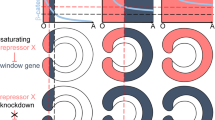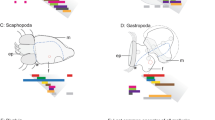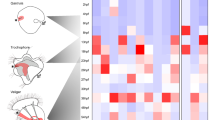Abstract
Most bilaterian animals possess a through gut with a separate mouth and anus1. It is commonly believed that during the transition from radial to bilateral symmetry, both openings evolved simultaneously by the lateral closure of a slit-like blastopore1,2,3,4. Molecular phylogenies however, place the acoel flatworms, which have only one opening to their digestive system, as the sister group to all remaining Bilateria5,6,7. To address how this single body opening is related to the mouth and anus of the protostomes and deuterostomes, we studied the expression of genes involved in bilaterian foregut and hindgut patterning during the development of the acoel Convolutriloba longifissura. Here we show that the genes brachyury and goosecoid are expressed in association with the acoel mouth, suggesting that this single opening is homologous to the mouth of other bilaterians8. In addition, we find that the genes caudal, orthopedia and brachyury—which are expressed in various bilaterian hindguts8,9,10—are expressed in a small region at the posterior end of the animal, separated from the anterior oral brachyury-expressing region by a dorsal domain of ectodermal bmp2/4 expression. These results contradict the hypothesis that the bilaterian mouth and anus evolved simultaneously from a common blastoporal opening, and suggest that a through gut might have evolved independently in different animal lineages.
This is a preview of subscription content, access via your institution
Access options
Subscribe to this journal
Receive 51 print issues and online access
$199.00 per year
only $3.90 per issue
Buy this article
- Purchase on Springer Link
- Instant access to full article PDF
Prices may be subject to local taxes which are calculated during checkout



Similar content being viewed by others
References
Nielsen, C. Animal Evolution 2nd edn (Oxford Univ. Press, 2001)
Arendt, D. & Nübler-Jung, K. Dorsal or ventral: similarities in fate maps and gastrulation patterns in annelids, arthropods and chordates. Mech. Dev. 61, 7–21 (1997)
Remane, A. Die Entstehung der Metamerie der Wirbellosen. Zool. Anz. 14, 18–23 (1950)
Sedgwick, W. On the origin of metameric segmentation and some other morphological questions. Q. J. Microsc. Sci. 24, 43–82 (1884)
Baguñá, J. & Riutort, M. The dawn of bilaterian animals: the case of acoelomorph flatworms. Bioessays 26, 1046–1057 (2004)
Ruiz-Trillo, I. et al. Acoel flatworms: earliest extant bilaterian Metazoans, not members of Platyhelminthes. Science 283, 1919–1923 (1999)
Wallberg, A., Curini-Galletti, M., Ahmadzadeh, A. & Jondelius, U. Dismissal of Acoelomorpha: Acoela and Nemertodermatida are separate early bilaterian clades. Zool. Scr. 36, 509–523 (2007)
Arendt, D., Technau, U. & Wittbrodt, J. Evolution of the bilaterian larval foregut. Nature 409, 81–85 (2001)
Simeone, A. et al. Orthopedia, a novel homeobox-containing gene expressed in the developing CNS of both mouse and Drosophila . Neuron 13, 83–101 (1994)
Wu, L. H. & Lengyel, J. A. Role of caudal in hindgut specification and gastrulation suggests homology between Drosophila amnioproctodeal invagination and vertebrate blastopore. Development 125, 2433–2442 (1998)
Grobben, K. Die systematische Einteilung des Tierreichs. Verh. Zool. Bot. Ges. Wien 58, 491–511 (1908)
von Graff, L. Die Organisation der Turbellaria Acoela (von Wilhelm Engelmann, 1891)
Haeckel, E. Die Gastraea-Theorie, die phylogenetische Classification des Thierreiches und die Homologie der Keimblätter. Jena. Z. Naturwiss. 8, 1–55 (1874)
Hyman, L. H. The Invertebrates. Vol II. Platyhelminthes and Rhynchocoela (McGraw-Hill, 1951)
Jägersten, G. On the early phylogeny of the Metazoa: the bilatero-gastraea theory. Zool. Bidr. Uppsala. 30, 321–354 (1955)
Salvini-Plawen, L. On the origin and evolution of the lower Metazoa. Z. Zool. Syst. Evolutionsforsch 16, 40–88 (1978)
Haszprunar, G. Plathelminthes and Plathelminthomorpha—paraphyletic taxa. J. Zool. Syst. Evol. Res. 34, 41–48 (1996)
Marcellini, S. When Brachyury meets Smad1: the evolution of bilateral symmetry during gastrulation. Bioessays 28, 413–420 (2006)
Tagawa, K., Humphreys, T. & Satoh, N. Novel pattern of Brachyury gene expression in hemichordate embryos. Mech. Dev. 75, 139–143 (1998)
Lartillot, N., Lespinet, O., Vervoort, M. & Adoutte, A. Expression pattern of Brachyury in the mollusc Patella vulgata suggests a conserved role in the establishment of the AP axis in Bilateria. Development 129, 1411–1421 (2002)
Neidert, A. H., Panopoulou, G. & Langeland, J. A. Amphioxus goosecoid and the evolution of the head organizer and prechordal plate. Evol. Dev. 2, 303–310 (2000)
Fröbius, A. C. & Seaver, E. C. ParaHox gene expression in the polychaete annelid Capitella sp. I . Dev. Genes Evol. 216, 81–88 (2006)
Lowe, C. J. et al. Anteroposterior patterning in hemichordates and the origins of the chordate nervous system. Cell 113, 853–865 (2003)
Christiaen, L. et al. Evolutionary modification of mouth position in deuterostomes. Semin. Cell Dev. Biol. 18, 502–511 (2007)
Henry, J. Q., Martindale, M. Q. & Boyer, B. C. The unique developmental program of the acoel flatworm, Neochildia fusca . Dev. Biol. 220, 285–295 (2000)
Denes, A. S. et al. Molecular architecture of annelid nerve cord supports common origin of nervous system centralization in bilateria. Cell 129, 277–288 (2007)
Lowe, C. J. et al. Dorsoventral patterning in hemichordates: insights into early chordate evolution. PLoS Biol. 4, e291 (2006)
Reisinger, E. Allgemeine Morphologie der Metazoa. Fortschr. Zool. 13, 1–82 (1961)
Dunn, C. W. et al. Broad phylogenomic sampling improves resolution of the animal tree of life. Nature 452, 745–749 (2008)
Martindale, M. Q., Pang, K. & Finnerty, J. R. Investigating the origins of triploblasty: ‘mesodermal’ gene expression in a diploblastic animal, the sea anemone Nematostella vectensis (phylum, Cnidaria; class, Anthozoa). Development 131, 2463–2474 (2004)
Acknowledgements
This work is supported by the National Science Foundation under the AToL program (EF05-31558) and NASA to M.Q.M. A.H. received further support from the Deutsche Forschungsgemeinschaft (HE5183/2-1). We thank K. Pang for improving the manuscript and A. Okuso for the drawings of the cnidarian and annelid.
Author information
Authors and Affiliations
Corresponding author
Supplementary information
Supplementary Information
This file contains Supplementary Figures and Legends 1-4, Supplementary Tables 1 – 2, Supplementary References and a Supplementary Video Legend (PDF 1637 kb)
Supplementary Video
This file contains a Supplementary Video (MOV 5719 kb)
Rights and permissions
About this article
Cite this article
Hejnol, A., Martindale, M. Acoel development indicates the independent evolution of the bilaterian mouth and anus. Nature 456, 382–386 (2008). https://doi.org/10.1038/nature07309
Received:
Accepted:
Published:
Issue Date:
DOI: https://doi.org/10.1038/nature07309
This article is cited by
-
Highly conserved and extremely evolvable: BMP signalling in secondary axis patterning of Cnidaria and Bilateria
Development Genes and Evolution (2024)
-
The brain regulatory program predates central nervous system evolution
Scientific Reports (2023)
-
Acoel single-cell atlas reveals expression dynamics and heterogeneity of adult pluripotent stem cells
Nature Communications (2023)
-
Saccorhytus is an early ecdysozoan and not the earliest deuterostome
Nature (2022)
-
A mosaic of conserved and novel modes of gene expression and morphogenesis in mesoderm and muscle formation of a larval bivalve
Organisms Diversity & Evolution (2022)
Comments
By submitting a comment you agree to abide by our Terms and Community Guidelines. If you find something abusive or that does not comply with our terms or guidelines please flag it as inappropriate.



